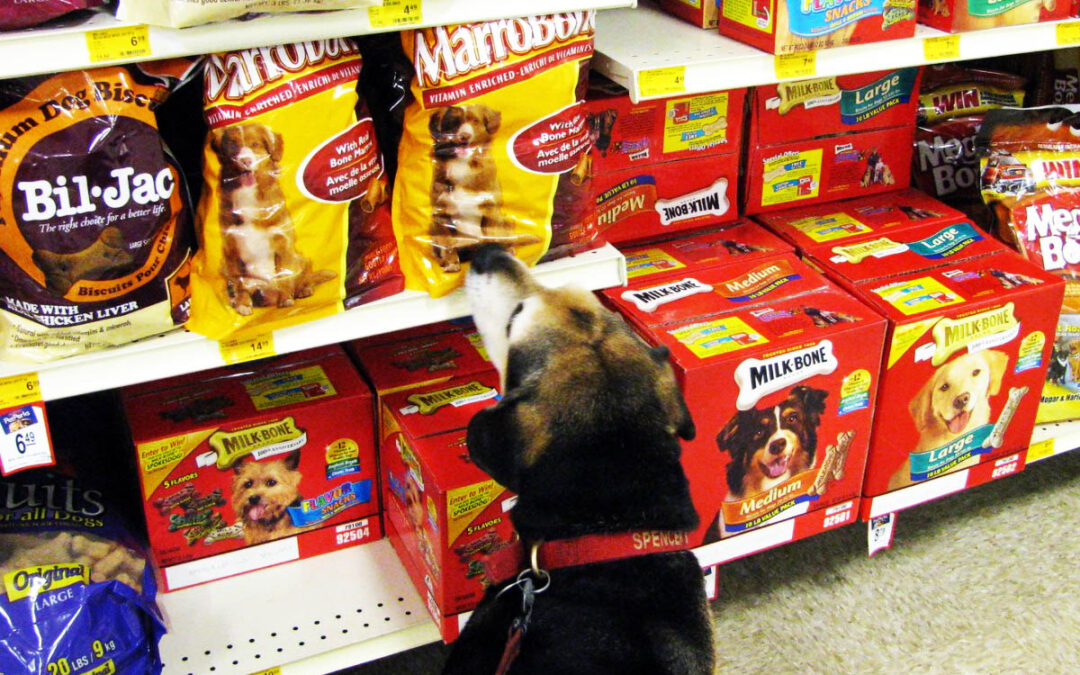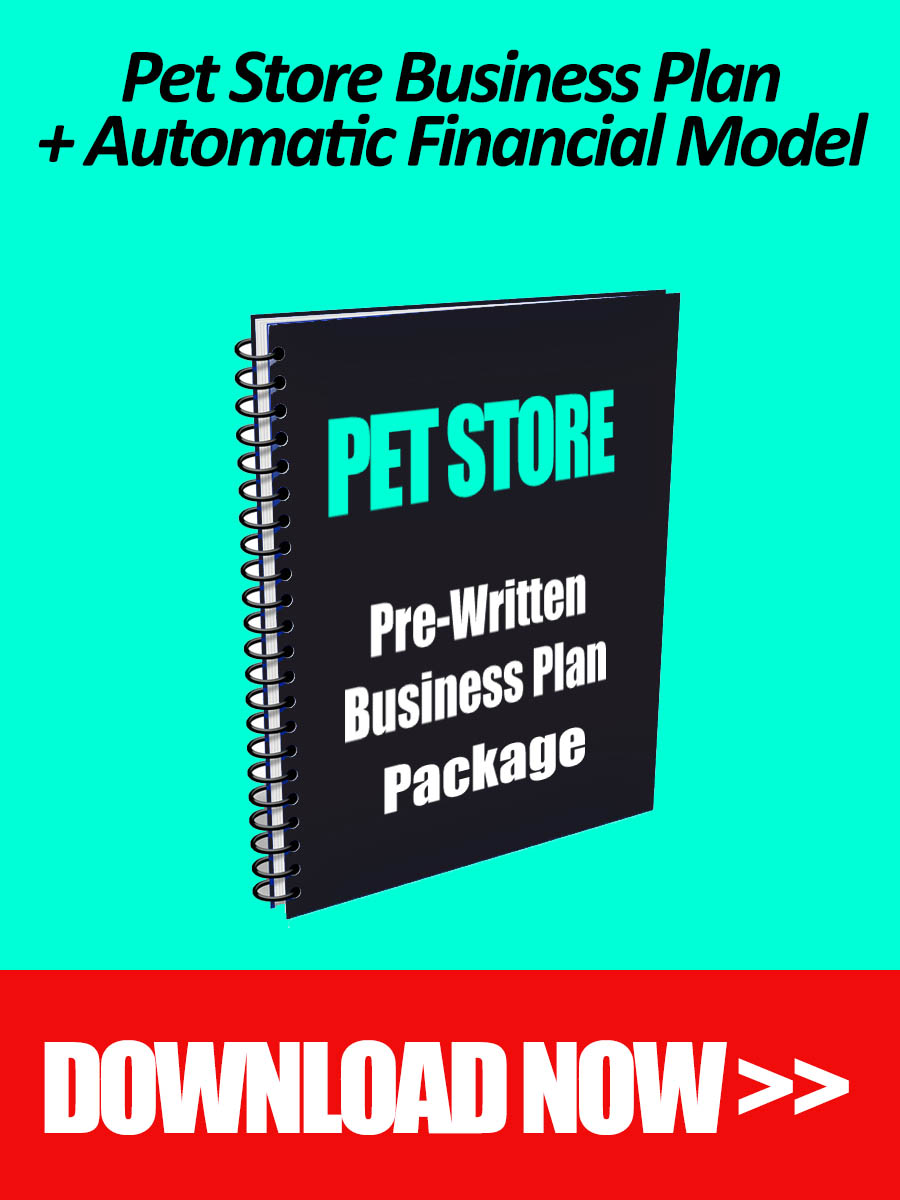Planning to launch your own pet store?
Well, before you open one, you will need to write a pet store business plan. A detailed business plan is a must-have when you are seeking funds from investors to launch a new business. That said, writing a business plan is recommended even when you are investing your own money. That’s because, a detailed pet store business plan works like a guiding force, showing whether your business is moving in the direction you want and how fast.
That brings us to the all-important question: What’s the best way to write a pet store business plan?
Before we move forward, we suggest you check out our ready-made pet store business plan template with automatic financials. Our solution includes a pre-written business plan in Word and a full-fledged financial model in Excel tailored to the pet store business and which you can customize fast and easy, no financial expertise required.
Now coming back to this post, we’ll show you all the steps involved in the process of crafting a detailed business plan. Wherever possible, we’ve also included a sample description to make things even simpler.
So let’s get this show on the road.
Step-by-step Guide for Crafting a Detailed Pet Store Business Plan
Step #1 – Pet Store Executive Summary
You may have heard that the executive summary is the most important section of a business plan. Guess what, that’s absolutely the case.
Write a compelling executive summary and the listeners may be all ears. Pen a boring one, and they will lose interest in your project faster than greased lightning.
A good pet store executive summary has the following attributes:
- It introduces readers to your project
- Provides key information about your project and clearly mentions what you want from the reader
- Piques the reader’s interest in your project and make them want to know more about it
These three are important qualities. Investors are not likely to go through a 30-page pet store business plan if they don’t find the executive summary exciting or relevant or professional.
So how can you crack this make-or-break part of your business plan?
Ensuring you include all important pieces of information in your summary is a good starting point. Your executive summary must shed light on:
- Your mission statement
- Your business model
- Your potential costs and Return on Investment (ROI)
- What action you want the reader to take (If you want to raise capital, clearly mention how much money you need)
Also, keep the following tips in mind when you sit down to write an executive summary:
Keep things short, simple, and sweet
A long-drawn-out summary may put off the reader. Worse, it shows you don’t value their time.
Instead of making the reader pull out the key points from the summary — chances of which happening are as good as nil, since the reader will sooner throw your plan into the wastebasket than put in so much effort — sum up the main information concisely and neatly, preferably in a bulleted list.
The executive summary is not where you should provide in-depth analysis. That is something you should do in the remaining sections of your business plan.
So what’s the ideal length for an executive summary?
Try not to exceed two pages. If you can say what you need to say in a single page, that’s better.
A typical pitfall many entrepreneurs run into is writing their executive summary first. As a result, they either include too much or too little information. Even though the executive summary is the most important part and the first section of your business plan, you should pen it last. This will help you decide what information to include in it.
Don’t forget to mention the problem your pet store would be addressing
What problem your business will solve? Mention that clearly in your executive summary.
How much capital your pet store needs?
Mention the exact figure you need instead of beating around the bush or giving a ballpark figure.
Here’s a sample executive summary
Susan’s Pet Shop is the answer to a unique opportunity. Joyville is a small community of 12,000 individuals. As of now it doesn’t have a single retail shop devoted solely to pet products, even though the value of the market is more than one million dollars. Prior experience, a suitable location, and a strong demand have created a great opportunity for success.
Susan’s Pet Shop is owned by Susan Robinson, a successful entrepreneur with prior experience in launching and running new businesses in this industry.
The shop’s tremendous geographical location (mention the location) provides an environment almost devoid of competition. The nearest pet shop is 30 minutes away. Locally, the competition comes from grocery stores, which offer only limited pet products.
Susan’s Pet Shop financial projections indicate that the business will start earning profit in its second year. Susan will invest $60,000 in her venture and is looking to raise $100,000 from investors.
Step#2 – Company Description
In this section, you should offer basic, precise information regarding your pet store. Specifically speaking, you should give details about the following things:
- Your company name
- Kind of ownership (corporation, partnership, sole proprietorship, etc.)
- Core team, their qualifications, and relevant experience
- Location
- Problems faced in the market and solutions you will be offering
- Short-term and long-term goals
- Your target audience
It is also good idea to include a short, precise mission statement in this section to acquaint investors with your business ethos.
Sample mission statement for a Pet Store
Susan’s Pet Shop mission is to assist pet owners by offering high-quality, eco-friendly foods and products designed to help improve the lives of their pets. By fulfilling our mission, we will help nurture healthier pets, protect the environment and make our customers happier pet owners.
Here’s a sample company structure for a Pet Store
Susan Robinson will own Susan’s Pet Shop. Susan is a successful marketer with prior experience in launching and marketing new businesses in the retail sector. Overall, she has more than 10 years of experience in retail. As a dog owner herself, Susan has a passion for pets and animals. She will be involved with the day-to-day operations of the pet shop. Susan also plans to hire two full-time employees to help her run the store. Each of these employees will undergo training before they start handling clients. Susan will train all the employees herself.
Upon commencement of operations, Susan’s Pet Shop will sell a full range of pet products, unlike the local competition that only sells limited products for pets.
Susan’s Pet Shop is strategically located on a busy street in Joyville. The location is extremely attractive, as it is just a walking distance from the local residential community.
The selected retail location is 1,500 square feet. It is currently divided into three distinct areas, which are as follows:
- A display space totaling 750 square feet
- An office area of 250 square feet
- A storage space of 500 square feet
While this arrangement offers more space than Susan’s Pet Shop requires during its initial year of operation, we are confident of utilizing the entire space by the second year as our product lines and inventory expand.
Step #3 – Products
In this section, talk about the products you plan to sell, your suppliers and the pricing / positioning you plan to adopt. For instance, you could be interested in launching an upscale pet boutique specializing in organic, natural pet foods to appeal to pet owners who want to buy the healthiest products for their cherished pets. This will justify a higher pricing and order values.
In that case, you can add something along the lines of, “Because of a large number of pet food recalls and a sharp increase in cases of pet food poisoning in recent years, there’s a substantial, growing, and unfulfilled demand for healthy, organic, natural pet products in our market. Our shop, which specializes in organic and eco-friendly pet products will fulfill this demand and help pet owners take good care of their pets.”
As you can see such a description is very specific. It shows clearly what products you will offer and how your offerings will fill a void in the present market.
Here’s another sample text you can refer to:
Susan’s Pet Shop is a retail business specializing in selling a full range of pet products, including, but not limited to, food, equipment, and toys. Our product categories include toys for cats, dogs, and other small pets; equipment for pet training and care; and dry and canned food. In the future, Susan’s Pet Shop may also start offering services such as pet obedience training and pet grooming.
All our suppliers are reputable, well-known businesses. We have contacted and taken feedback from their references. All their existing customers have expressed satisfaction with the quality and service offered by these suppliers. Manufacturers’ products carried by these suppliers are very popular with pet owners.
Step #4 – Pet Store Market and Customer Analysis
This is the section in which you should share information about the local market and your targeted customers. You can choose to present them together or as separate sub-sections.
When providing market analysis, make sure you give unambiguous answers to these questions:
- What’s the growth overview of your industry?
- Who are your direct and indirect competitors?
- Why would customers choose you over competition? What are your strong points or USP (unique selling proposition)?
When writing customer analysis, talk about people who will buy from you. That is, what is your target audience?
Here’s a sample customer analysis
Initially, Susan’s Pet Shop will target the clients of the local animal clinic. Through a partnership with the local pet clinic, the clinic will introduce Susan Pet Shop to roughly 1,000 pet owners in Joyville. Susan’s Pet Shop will start targeting non-clinic patrons after the first 6 months.
Step #5 – Competition Analysis for a Pet Store
In this section talk about your competitors, direct and indirect, as well as highlight the competitive advantages you have over them.
Here’s a sample competition analysis:
The closest pet shop is almost 30 minutes away from the local community. Susan’s Pet Shop local competition mainly comes from three grocery stores. These grocery stores offer limited products, and a survey of the local animal clinic shows that nearly 70% of local pet owners would prefer to buy various pet products from a specialized pet shop like Susan’s Pet Shop.
Step #6 – Marketing plan for a Pet Store
You can refer to the following sample to write your own pet store marketing plan.
Susan’s Pet Shop has formed a long-term, mutually benefiting relationship with the local animal clinic, which is located within its 100-meter radius. This strategic partnership gives Susan’s Pet Shop a strong advantage over the competition.
As a part of a joint marketing strategy, the local animal clinic will recommend Susan’s Pet Shop to all its clients. This marketing strategy emphasizes holistic, organic, high-quality, and all-natural pet products and quality pet care and identifies the clinic and Susan’s Pet Shop as quality providers.
Our business will rely on the below channels to promote its offering:
Online Marketing
Susan’s Pet shop will create a smart, sleek, and customer-oriented website. The website will be placed on high ranks on search engines through SEM and SEO. Local customers will be able to place their orders online if they wish to. We will also create social media accounts to reach out to the local community through various social media channels.
Print Advertising
Susan’s Pet shop will print a story in the local newspaper when it holds its grand opening. Along with the story, the shop plans to run a quarter-page in the Sunday edition of the local newspaper for a period of three months.
Step #7 – Financial Plan for a Pet Store
Developing a full-fledged financial plan for your pet store is an integral part of your business plan. Your financial plan should ideally include the following sections:
- Cost model
- Revenue model and sales projections
- Income statement forecast
- Cash flow statement forecast
- Balance sheet forecast
- ROI and profitability analysis
- Capital raise and use of funds
You may refer to our automatic pet store financial plan to build a robust financial model fast and easy, no accounting knowledge required.
Investors focus a lot on the numbers and hence writing a proper financial plan is a crucial part of your pet store business plan.
Step #8 – Appendices and Exhibits
Here you can add all additional documents and extra information such as:
- Market survey if you have done one
- Detailed statistics
- Sample branding materials
- Sample store layouts…etc.
Wrapping Up
A pet store business plan is an important document whether you are attracting investors or need a roadmap to execute your project. If you require help building a robust business plan, we recommend your download our ready-made pet store business plan with automatic financials. This is the most convenient and cost-effective solution.



